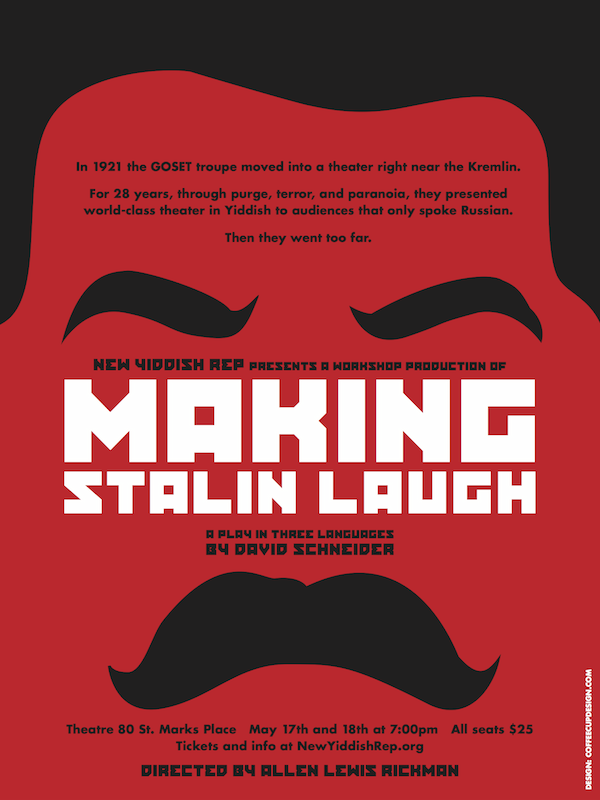VARTN AF GODOT
All photos © Ron Glassman
All photos © Ron Glassman
| Samuel Beckett’s 20th Century Classic in Yiddish!? Nu Farvus? |
| Sixty years after its premier on January 3, 1953 in Paris at the Theatre de Babylone, Waiting for Godot is being presented in Yiddish for the first time ever, in a city that has given a home to Yiddish-speaking people and their theatre for over a hundred years. While the play provoked consternation or downright rejection among its first audiences, it has since attained universal acclaim as a quintessential expression of human existence. However, the choice of performing the play in Yiddish demands a different approach than if one were to do the play in French, English, or German. Yiddish is not only a language, it is emblematic of a culture that was targeted for destruction; the language evokes a particular historical context once it is detached from nostalgia. The survival of Yiddish against historical odds and the fact that it is now studied by young people in universities all over the world is testimony to the resilience of a language and culture in which tears of laughter and tears of sorrow flow from the same source: a profound sense of the absurdity of existence. Beckett’s phrase “I can’t go on, I’ll go on” embodies that very paradox. Samuel Beckett wrote Waiting for Godot between October 1948 and January 1949, when Europe was still reeling from the cataclysm of the war and the Holocaust, with millions of displaced people roaming the war-scarred countryside: survivors of concentration camps; escaped or released prisoners of war; refugees from the East; and war criminals of all stripes. Food was scarce everywhere, with fields destroyed and famine raging during the extreme winter of 1946/47. In 1942, Beckett and his wife Suzanne fled Paris and made their way to the South of France, mostly on foot, after the Resistance cell of which they were members was denounced to the Gestapo. After the war, in 1946, while working for the Irish Red Cross in the bomb ravaged city of St. Lo, Beckett saw destruction and universal human misery first-hand. In fact, Beckett told his biographer, James Knowlson, about the loss of one of his best friends, Alfred Peron, a French Jew and fellow member in the same Resistance cell, who was captured and interned in Mauthausen. “After the war, it was terrible! The forces just opened the extermination camps as they came through. They had nothing to eat, those of them who were left alive. So there was cannibalism. Alfred [Peron] wouldn’t do it. Amazingly he got as far as Switzerland and then he died of malnutrition and exhaustion [in June 1945]. After the war we saw quite a bit of Mania, Alfred’s widow. She used to check on the French of my work, I remember.”1 In the first draft of En Attendant Godot, Beckett gives the name of Levy to the character who eventually becomes Estragon2, an indication that the personal loss of a close friend, and the reality of the horror, may have inspired Beckett as much as the glimmer of hope for a future that could be found in Alfred and Mania Peron’s twin boys, or in a couple of new leaves sprouting from a ravaged tree. The play is in very good hands for the upcoming production. Moshe Yassur, the director, grew up with Yiddish as his first language, and as a child survived the 1941 pogrom, and the war, in Iasi, Romania. His extensive theatre experience included not only the Yiddish theatre (in Iasi) but also working in Paris with Jean-Marie Serreau, the director of the Theatre de Babylone, at the time when Serreau pioneered the work of Beckett and Ionesco. The acting ensemble includes David Mandelbaum, Artistic Director of New Yiddish Rep, a veteran of the Yiddish theatre; the magician/actor Shane Baker, who also translated the play into Yiddish; Avi Hoffman, a luminary of the American Yiddish theatre, and Rafael Goldwaser from the Luftteater in Strasbourg, France, who has created uniquely stylish performances derived from classical Yiddish literature. This co-production by New Yiddish Rep and Castillo Theatre, a socially engaged theatre with a long history of espousing a political perspective, promises to give a fresh look at a play that traditionally has been placed into a neutral landscape. - Beate Hein-Bennett, Dramaturg 1 James and Elizabeth Knowlson, eds. Beckett Remembering, Remembering Beckett: A Centenary Celebration (New York: Arcade Publishing, 2006) p. 86. 2 James Knowlson, Damned to Fame: The Life of Samuel Beckett (New York: Simon and Schuster, 1996) p. 344. Knowlson mentions that shortly before Beckett wrote Godot, Georges Loustaunau-Lacau, a survivor of Mauthausen, had published a book describing life in the camp where Peron had been an inmate. Mania Peron knew the book and may have lent it to Beckett. The first film footage revealing the horrors of the death camps had already been made public by the time he wrote the play |




